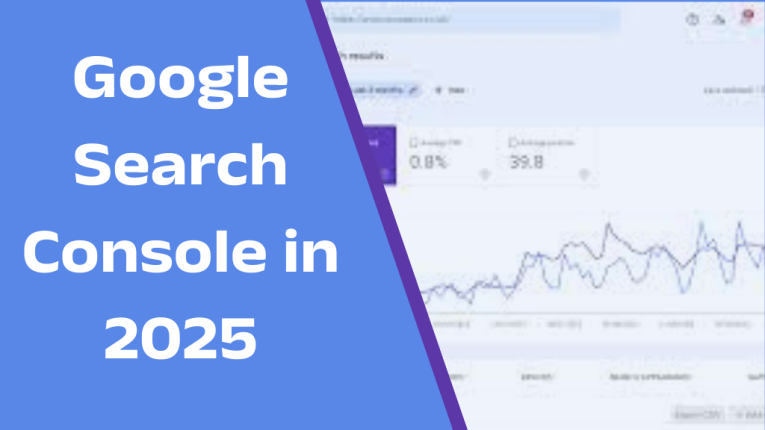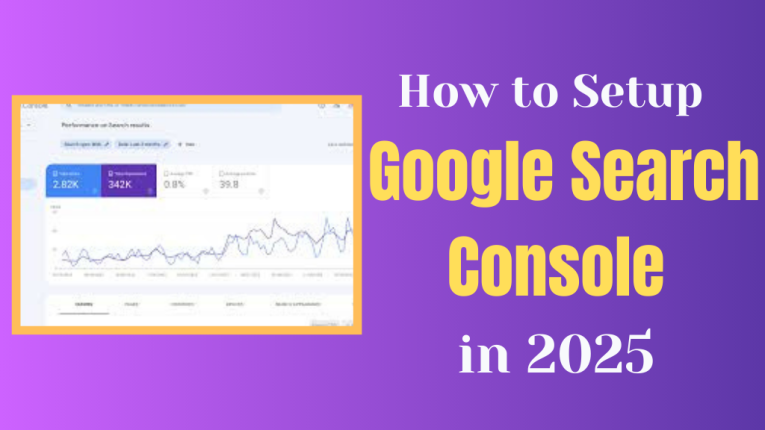
- August 30, 2025
- Tejhaksh
- 0 Comments
- Google Search Console, Uncategorized
Master in Google Search Console: Full Guidance for Beginner’s in 2025
Google Search Console (GSC) is a very useful and absolutely free tool in the world of digital marketing, created by Google. With this tool, improving your site’s SEO and search performance becomes easy.
No matter if you run a blog, a business, or work in digital marketing, using Google Search Console correctly in 2025 can help you advance online.
In this guide, we will explain in an easy way what Google Search Console is, how to set it up and how to use it to improve your website’s performance and ranking.
What is Google Search Console?
Google Search Console (GSC), formerly known as Google Webmaster Tools, is a free SEO tool from Google. It is very useful for website owners, bloggers and digital marketers. With its help, you can see how your website appears on Google Search and monitor its performance.
Think of it like this – it is the health checkup and report card of your website.
While Google Analytics tells you what people are doing after visiting your website, Google Search Console tells how people are reaching your site through Google Search.
In this, you get many important information, such as:
- How your website is performing in Google Search.
- Which keywords are bringing traffic to you.
- Are your web pages indexed correctly or not.
- Is there any problem in using the site on mobile?
- Is there any security problem on the website like malware or spam?
In 2025, when Google is constantly updating its algorithms and AI-based search is growing rapidly, using Google Search Console is no longer just an option. It is a must-have tool for anyone who is really serious about SEO (search engine optimization).
Why Google Search Console is Important in 2025?
By 2025, the online space has become more competitive than ever. With millions of websites vying for attention, guesswork is no longer the answer. Here’s where Google Search Console (GSC) proves to be invaluable. It’s not just a reporting tool, it’s the path to your SEO success.
Why GSC is Important:
1. Understand website performance
GSC tells you how many clicks your site is getting, how often your site appears in search (impressions), what your average ranking is, and how much people are clicking through your site (CTR). This helps you figure out which pages are performing well.
2. Get insight into the right keywords
Rather than guessing, GSC reveals the exact keywords that bring traffic to your website. This allows you to improve your content strategy and focus on keywords that can bring in more visitors.
3. Fix indexing issues
If Google can’t index or crawl your site’s pages properly, they won’t appear in search. GSC notifies you of these issues (blocked pages, server errors, duplicate content) so you can fix them immediately.
4. Create a mobile-friendly website
Google now does mobile-first indexing, so looking good on mobile is a must. GSC shows you mobile-related issues—like small text, slow loading, or overlapping designs—so you can improve your site.
5. Detect errors quickly
GSC alerts you immediately if your site has issues like 404 errors, broken links, security issues, or Google penalties. Early detection allows you to fix them quickly and protect your rankings.
6. Improve SEO based on data
SEO is no longer based on guesswork. GSC gives you real data so you can see where your site stands, which pages need improvement, and where there is opportunity for growth. Even small changes can add up to a huge boost in your rankings and traffic over time.
How to Set Up Google Search Console in 2025
Setting up Google Search Console (GSC) for beginners might seem a bit daunting, but it is actually quite easy. All you have to do is add your website and then monitor its performance. For this, follow these simple steps:
Step 1: Sign in to Google Search Console
- Visit Official Website: search.google.com/search-console
- Log in with the Google account associated with your website or business for best results.
Step 2: Add your website
After logging in, click on “Add Property”.
Then you will have two options:
- Domain Property – This covers all subdomains and links (http, https, www etc) of your website. (This is the best option)
- URL Prefix – This option includes only the specific URL you enter.
Tip: Choose Domain Property to cover the whole website.
Step 3: Verify your website
Google offers several ways to ensure that you are the real owner of the website:
- Domain verification – Add a DNS record at your domain registrar (such as GoDaddy, Namecheap, or hosting provider).
- HTML File Upload – Download the verification file from GSC and place it in your website’s root directory.
- Meta tag verification – Paste the meta tags in thesection of the website.Google Analytics or Tag Manager – If already installed, you can perform instant verification with
- one click.
Once verification is complete, your website will be added to GSC.
Step 4: Submit your sitemap
- A sitemap is a map of your website. It helps Google find and index your website pages easily.
- Go to the Indexing → Sitemaps section.
- Enter your sitemap URL (e.g.: https://www.yoursite.com/sitemap.xml).
- Click Submit.
Now Google will be able to crawl and index your website quickly and accurately.
Key Features of Google Search Console for Beginners
Once your website is connected, it’s time to understand the dashboard and properly utilize all of its features.
1. Performance Report
- This report shows how many clicks, how many impressions, click-through rate (CTR) and average ranking your website has.
- This helps you understand which keywords are driving the most traffic to your site.
- You can also filter the data by country, device or date.
Example: If a page is visible to more people but getting fewer clicks, it means you need to improve your meta title and description.
2. URL Inspection Tool
- This tool tells you if a page is indexed in Google or not.
- You can check whether the page has been crawled and identify any errors.
- You can also submit new or updated content for indexing.
Tip: Use this after publishing a blog post or a new page so that the page can be indexed quickly.
3. Coverage Report
- This report shows what errors are on your site, such as “404 page not found”, “server error” or “redirect page”.
- It shows which pages are out of indexing.
- This helps you quickly spot and resolve technical SEO problems on your website.
4. Sitemap Section
- Here you can submit and check the sitemap of your website.
- Make sure that all the important pages are included in the sitemap.
- Don’t forget to update the sitemap when there are any major changes to the website.
5. Mobile Usability
- This tool tells you if your website works well on mobile.
- It shows issues like: buttons or links are too close, text is small, or content is running off the screen.
Note: Google is moving to mobile-first indexing in 2025, so it’s important to fix these issues quickly.
6. Core Web Vitals
This tool shows your website’s loading speed and user experience.
It includes:
- LCP (Largest Contentful Paint) – How quickly the main content of the page loads.
- FID (First Input Delay) – How long it takes for a response to appear when you click or tap on the page.
- CLS (Cumulative Layout Shift) – How often the page layout moves or changes.
If core web vitals are poor, it can lower your search rankings.
7. Links Report
- This report displays both the internal and external links on your website.
- It lets you know which pages are getting the most links and which domains are linking to your site.
- It can be used to create a backlink strategy and improve content.
8. Security and Manual Actions
- This tool tells you if your website has been hacked or has received any penalties from Google.
- This allows you to fix issues quickly and protect your search rankings.
Best Practices for Using Google Search Console in 2025
It’s not enough to just set up Google Search Console (GSC)—you also need to learn how to use it correctly. To get the most out of it in 2025, follow these simple and effective steps:
1. Check your website regularly
Try to check GSC at least once a week regularly. This lets you know how your site is doing, what the traffic is like, and which keywords are working. Also, if there is a sudden drop in clicks, impressions, or rankings, you can immediately notice it.
2. Increase CTR (click-through rate)
If a page is getting a lot of impressions but few clicks, it means people are seeing your site in search but not clicking. So improve your meta title and meta description so that they are catchy and contain the right keywords. You can increase clicks by adding numbers, questions or emotional words.
3. Focus on “easy win” keywords
Find keywords where your site already ranks 5th to 20th. With a little content improvement, better linking, and updated information, you can easily move these into the top 3, which brings in more traffic.
4. Fix errors quickly
Problems that show up in coverage such as 404 pages, duplicate content, or indexing issues can reduce your website’s ability to appear in search.
Use the coverage report to identify and fix these issues quickly so your SEO isn’t affected.
5. Improve mobile performance
Google now does mobile-first indexing, so it’s important that your site looks good on mobile. Using GSC’s Mobile Usability report, you can fix issues like:
- Text is too small
- Buttons or links overlap
- Pages load slowly
6. Track and improve Core Web Vitals
Page load speed and user experience are now key factors in ranking. GSC’s Core Web Vitals report helps you measure:
- LCP (Largest Contentful Paint) – Tracks the time it takes for your page’s main content to load.
- FID – shows the time it takes for your page to respond to a user’s first interaction.
- CLS (Cumulative Layout Shift) – how stable the page layout is.
Boost site speed by compressing images, enabling caching, reducing JavaScript, and using stable hosting.
7. Do internal linking to strengthen weak pages
The GSC link report highlights pages that are weak in internal or external links. Using this information, you can add internal links from your strong and popular pages to weak pages. This increases the chances of those pages appearing in search.
8. Index new or updated content quickly
When you add a new post or make changes to an old page, request indexing with the URL inspection tool. This allows Google to crawl and update your site quickly, and your content can appear in search results sooner.
Search Console Pro Tip for 2025:
Combine the information you get from GSC with tools like Google Analytics, SEMrush to create your complete SEO strategy. GSC gives you technical data, while Analytics tools show user behavior. By combining these, you can create the best development plan for your website.
Google Search Console vs. Google Analytics
Many beginners frequently confuse Google Search Console (GSC) with Google Analytics (GA4). Both are important tools, but the purposes of using them are different.
Google Search Console (GSC)
- This tool allows you to track your website’s visibility in Google Search results.
- It shows which keywords bring traffic, your impressions, clicks, CTR, and highlights indexing, mobile, or technical issues affecting your site.
- It lets you understand how Google sees your website and what you can do to improve rankings.
Google Analytics (GA4)
- This tool tells you what users do after they visit your website.
- Tracks data like traffic sources, user demographics, bounce rate, session duration, conversions, and sales.
- It lets you know how visitors are interacting with your site’s content and which marketing channels are working the most.
Why both tools are needed in 2025
- GSC tells you how people get to your site from Google Search.
- GA4 tells you what they do once they’re on your site.
Using them together gives you a complete 360° view of your website—from visibility on search engines to user engagement and conversions.
Advanced Google Search Console Tips for 2025
Once you understand the basics of Google Search Console (GSC), it’s time to take it to the next level. These advanced tips will help new users identify new opportunities, increase rankings, and stay ahead of competitors in 2025.
1. Find new content opportunities
Check out GSC’s query report and identify keywords your site already ranks for but aren’t being fully utilized.
Example: If a page is ranked 10-20, create a new blog post for it or update old content. This can lead to additional traffic without much effort.
2. Track international SEO
If your site serves international users, GSC shows how your site is performing in which countries and languages.
Filtering by country or language allows you to create localized content and improve multilingual SEO.
3. Track seasonal and trending keywords
Search patterns change throughout the year. GSC helps you identify which keywords bring in seasonal traffic.
Example: E-commerce sites can track when keywords like “holiday gifts” or “summer sale” drive more traffic and prepare content in advance.
4. Combine GSC with other SEO tools
Combine your GSC data with tools like SEMrush, Ahrefs, Moz or Google Looker Studio.
This allows you to:
- Create detailed dashboards
- Combine search performance with analytics data
- Easily track progress
5. Analyze core web vitals
Paying attention to core web vitals can help your site perform better in the rankings.
Check out GSC’s Page Experience report and make sure your site loads fast, is interactive and remains stable to look better than the competition.
6. Update old content
You don’t just need to create new content. GSC shows which pages are losing traffic or impressions.
Adding new keywords, data and visuals to old posts can help them rank higher again.
Pro tip:
Combine GSC insights with AI tools to further strengthen your SEO strategy in 2025. This blend of data and automation ensures long-term success.
Final Thoughts
Learning Google Search Console (GSC) in 2025 is no longer an option—it’s a must-have for every website owner or digital marketer looking for SEO. Whether you run a blog, an e-commerce website, or manage a business page, GSC can help you improve rankings, fix technical SEO issues, improve user experience, and increase traffic.
Take small steps at first: verify your site, submit a sitemap, and view weekly performance reports. Gradually, as you understand GSC’s features, you’ll realize how powerful this tool is in improving your website’s future.
If you want to stay ahead in SEO in 2025, make Google Search Console your most trusted companion. Regular monitoring and data-driven improvements can ensure your website’s success.





Leave a Comment